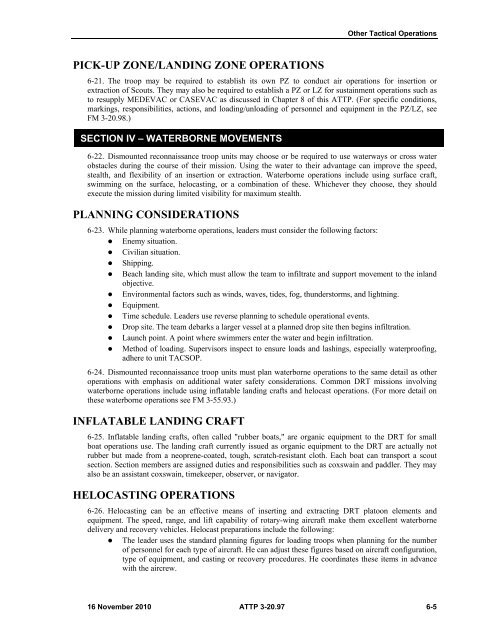Dismounted Reconnaissance Troop - Army Electronic Publications ...
Dismounted Reconnaissance Troop - Army Electronic Publications ...
Dismounted Reconnaissance Troop - Army Electronic Publications ...
Create successful ePaper yourself
Turn your PDF publications into a flip-book with our unique Google optimized e-Paper software.
PICK-UP ZONE/LANDING ZONE OPERATIONS<br />
Other Tactical Operations<br />
6-21. The troop may be required to establish its own PZ to conduct air operations for insertion or<br />
extraction of Scouts. They may also be required to establish a PZ or LZ for sustainment operations such as<br />
to resupply MEDEVAC or CASEVAC as discussed in Chapter 8 of this ATTP. (For specific conditions,<br />
markings, responsibilities, actions, and loading/unloading of personnel and equipment in the PZ/LZ, see<br />
FM 3-20.98.)<br />
SECTION IV – WATERBORNE MOVEMENTS<br />
6-22. <strong>Dismounted</strong> reconnaissance troop units may choose or be required to use waterways or cross water<br />
obstacles during the course of their mission. Using the water to their advantage can improve the speed,<br />
stealth, and flexibility of an insertion or extraction. Waterborne operations include using surface craft,<br />
swimming on the surface, helocasting, or a combination of these. Whichever they choose, they should<br />
execute the mission during limited visibility for maximum stealth.<br />
PLANNING CONSIDERATIONS<br />
6-23. While planning waterborne operations, leaders must consider the following factors:<br />
Enemy situation.<br />
Civilian situation.<br />
Shipping.<br />
Beach landing site, which must allow the team to infiltrate and support movement to the inland<br />
objective.<br />
Environmental factors such as winds, waves, tides, fog, thunderstorms, and lightning.<br />
Equipment.<br />
Time schedule. Leaders use reverse planning to schedule operational events.<br />
Drop site. The team debarks a larger vessel at a planned drop site then begins infiltration.<br />
Launch point. A point where swimmers enter the water and begin infiltration.<br />
Method of loading. Supervisors inspect to ensure loads and lashings, especially waterproofing,<br />
adhere to unit TACSOP.<br />
6-24. <strong>Dismounted</strong> reconnaissance troop units must plan waterborne operations to the same detail as other<br />
operations with emphasis on additional water safety considerations. Common DRT missions involving<br />
waterborne operations include using inflatable landing crafts and helocast operations. (For more detail on<br />
these waterborne operations see FM 3-55.93.)<br />
INFLATABLE LANDING CRAFT<br />
6-25. Inflatable landing crafts, often called "rubber boats," are organic equipment to the DRT for small<br />
boat operations use. The landing craft currently issued as organic equipment to the DRT are actually not<br />
rubber but made from a neoprene-coated, tough, scratch-resistant cloth. Each boat can transport a scout<br />
section. Section members are assigned duties and responsibilities such as coxswain and paddler. They may<br />
also be an assistant coxswain, timekeeper, observer, or navigator.<br />
HELOCASTING OPERATIONS<br />
6-26. Helocasting can be an effective means of inserting and extracting DRT platoon elements and<br />
equipment. The speed, range, and lift capability of rotary-wing aircraft make them excellent waterborne<br />
delivery and recovery vehicles. Helocast preparations include the following:<br />
The leader uses the standard planning figures for loading troops when planning for the number<br />
of personnel for each type of aircraft. He can adjust these figures based on aircraft configuration,<br />
type of equipment, and casting or recovery procedures. He coordinates these items in advance<br />
with the aircrew.<br />
16 November 2010 ATTP 3-20.97 6-5

















